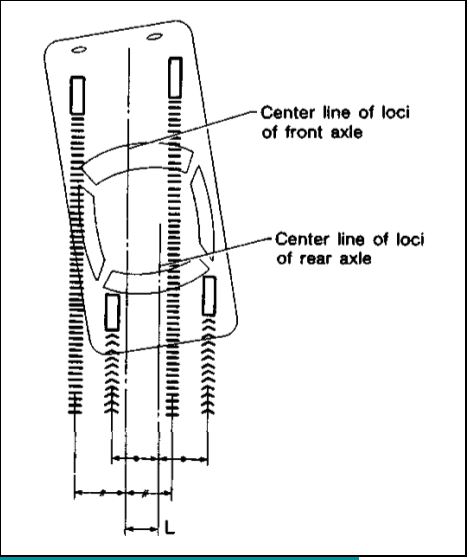Wheel Alignment For Subaru:
6. Thrust Angle
Inspection
1.) Position the vehicle on a level surface.
2.) Move the vehicle 3-4 meters directly forward.
3.) Determine the locus of both front and rear axles.
4.) Measure distance “L” between center line of loci of the axles.

20′ when “L” is equal to or less than 15 mm (0.59 in).
Adjustment
Make thrust angle adjustments by turning the toe-in adjusting bolts of the rear suspension equally in the same direction.
For reference: When one rear wheel is adjusted in a toe-in direction, adjust the other rear wheel equally in a toe-out direction, in order to make the thrust angle adjustment. When left and right adjusting bolts are turned incrementally by one graduation in the same direction, the thrust angle of the AWD model will change approximately 10′ [“L” is almost equal to 7.5 mm (0.295 in)] and the thrust angle of the FWD model will change approximately 12′ [“L” is almost equal to 9 mm (0.35 in)].
Thrust angle: 0° ± 20′
Note: Thrust angle refers to a mean value of left and right rear wheel toe angles in relation to vehicle body center line. Vehicle is driven straight in the thrust angle direction while swinging in the oblique direction depending on the degree of the mean thrust angle. Thrust angle = r
Thrust angle = r ∂ – ß r = 2
∂: Right rear wheel toe angle
ß: Left rear wheel toe angle
Note: Use only positive toe-in values from each wheel to substitute ∂ for and ß in the equation.
7. Steering Angle
Inspection
1.) Place the vehicle on a turning radius gauge.
2.) While depressing the brake pedal, turn the steering wheel fully to the left and right. With the steering wheel held at each fully turned position, measure both the inner and outer wheel steering angle.
Steering angle:
Inner wheel 37.6° ± 1.5°
Outer wheel 32.6° ± 1.5°
Adjustment
Turn the tie-rod to adjust the steering
angle of both inner and outer wheels.
